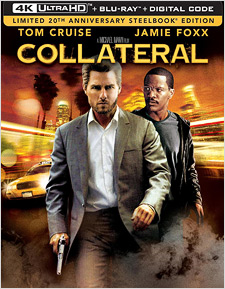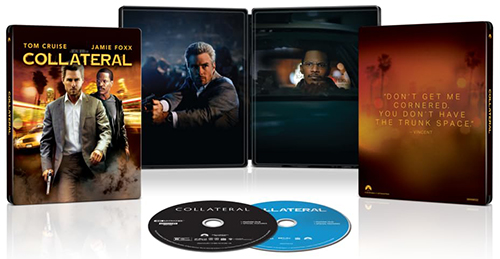Collateral: Limited 20th Anniversary Steelbook Edition (4K UHD Review)

Director
Michael MannRelease Date(s)
2004 (August 6, 2024)Studio(s)
Dreamworks Pictures (Paramount Pictures Home Entertainment)- Film/Program Grade: A-
- Video Grade: B+
- Audio Grade: A-
- Extras Grade: B+
Review
Michael Mann isn’t often mentioned in context with Howard Hawks, but he’s arguably the most noteworthy modern heir to the throne of Hawksian professionalism. Mann has been making films analyzing professionals and professionalism ever since his debut feature Thief in 1981, and arguably even in his previous made for television effort The Jericho Mile. Regardless of whether his stories revolve around thieves, police officers, frontiersmen, boxers, or distance runners, his films always delve deeply into the expertise that his characters possess. That’s no less true of his 2004 thriller Collateral, even though it wasn’t his own project and he was brought on board partway through the development process. Yet it’s easy to see why Stuart Beattie’s script appealed to him, and Collateral ended up fitting in perfectly with the rest of his filmography.
The story for Collateral involves Max (Jamie Foxx), an L.A. cab driver whose ride is hijacked one night by Vincent (Tom Cruise). Vincent initially seems like an ordinary businessman, but he’s really a hitman with a string of targets that he needs to eliminate in just one night. Vincent is a perfectly amoral professional killer; for him, killing is just a job, but it’s a job that he does quite well. In typical Mann fashion, Cruise underwent a rigorous training program in order to learn how to use all of the tools of the trade with maximum comfort and efficiency (it was the first time that Cruise had trained with live ammunition). That preparation paid off beautifully; Cruise is completely believable as a professional killer. In this case, Mann’s own professionalism as a filmmaker gelled perfectly with Cruise’s obsessive-compulsive nature.
What may be a little less obvious at first glance is that Max is equally professional, albeit in his own peculiar way. Collateral quickly and deftly establishes that Max has a savant-like ability to calculate the most efficient route to any destination, even though doing so might make less money for him. Yet there’s still a crucial difference between Max’s brand of professionalism and Vincent’s, and that’s what drives the entire story. Vincent’s career is based on calculated risk; he boldly does whatever he needs to do in order to finish the job at hand, improvising as necessary to complete his contracts on time. Max, on the other hand, is incapable of taking any risks whatsoever—and that’s equally true of both his personal and his professional life.
Vincent chooses to use Max as a chauffeur because he sees that Max is passive and easy to push around. Yet he soon recognizes Max’s abilities and understands that the two of them are kindred spirits in terms of their professionalism. Once he becomes aware of this, he’s annoyed by Max’s personal paralysis. He starts to goad Max out of his inertia, but by forcing Max outside of his comfort zone, Vincent inadvertently removes the one thing that was necessary to keep the cab driver under control. Vincent takes personal offense at the fact that a professional would lack the courage to take action, so he helps Max to gain that courage, and ends up paying the price for doing so.
Mann’s own professionalism and willingness to take risks resulted in him choosing to shoot a high percentage of Collateral on digital video during an era in which the technology had yet to mature. He’d experimented with doing so for a few shots in Ali, and he loved the fact that the limited exposure latitude of digital allowed him to capture images that would have been impossible to shoot on film. It meant that he was able to keep the foreground characters and the background scenery equally well exposed during Collateral’s extensive nighttime exterior work. He even embraced the flaws inherent to early digital cinematography; he wasn’t afraid to allow video to look like video, so Collateral is filled with digital noise and motion artifacts. That created a clash with his original cinematographer Paul Cameron, who left the project early on and was replaced by Dion Beebe.
Mann also continued his use of unconventional framing, frequently violating the standard rules of screen direction. He loves framing characters off to one side and having them look off screen rather than back into the empty side of the frame—it creates a feeling of distance between characters who don’t see eye-to-eye. For technical reasons like this as well as for thematic reasons, Collateral is the perfect expression of Mann’s own tightly controlled risk-taking. Collateral is also the perfect fusion of characters marked by Hawksian professionalism with a director known for his own professionalism and attention to detail. Yet despite the fact that the characters and the filmmaker may have been taking risks together, nothing was really left to chance. That’s because everyone was far too good at their respective jobs, making Collateral a master class in professional expertise on both sides of the camera.
Dion Beebe and Paul Cameron shot Collateral on a combination of 35mm film and digital video. The daylight scenes and most interiors were shot in Super-35 format using Arriflex 435 cameras (as well as Panavision Panaflex Millennium and Millennium XL cameras) with Panavision Primo spherical lenses. Nighttime exteriors (including vehicular interiors) were captured at 1080p using Sony HDW-F900 and Thomson Viper digital cameras with Zeiss DigiPrime lenses. While the sequences that were captured with the Sony had to be cropped to achieve a 2.39:1 aspect ratio at a final resolution of 1920x764, the Viper could perform a native internal anamorphic squeeze, and so those shots were at the full 1920x1080 resolution. The production experimented with the full 4:4:4 uncompressed RAW FilmStream mode for the Vipers, but the decision was made to use the compressed VideoStream mode instead for various practical reasons. Post-production work was finished as a 2K Digital Intermediate, framed at 2.39:1 for its theatrical release.
For this 4K version, Paramount upscaled that DI to 4K and graded it for HDR under Mann’s supervision (both Dolby Vision and HDR10 are included on the disc). The improvements in the sequences that were shot on film are modest but still perceptible. They do show a slight increase in fine detail, while the sequences that were shot on video definitely don’t. Many of the nighttime video shots have flatter contrast and elevated black levels by design, but the daylight shots and the interiors do feature improved contrast and black levels. A few of the club scenes also display slightly more saturated colors. Just as importantly, the digital noise is handled much better here than it is on the Blu-ray version thanks to the greater breathing room offered by the Ultra HD format—there aren’t any compression artifacts adding more noise on top of the existing noise. The motion artifacts are still present, but once again those were inherent to the original cinematography.
Primary audio is offered in English 5.1 DTS-HD Master Audio. While an Atmos remix might have been welcome, Mann is no slouch when it comes to 5.1 mixes. Much of the sound design in Collateral is handled subjectively from the point of view of the characters—for instance, when Max shuts the door of his cab, ambient sounds are instantly dialed down to mimic the feeling of isolation that he gets when he goes to work. Things do spring to aggressive life when appropriate, with plenty of dynamic impact from the gunfire and car crashes, as well as strongly directional effects like helicopters circling the viewer. The sound design in Mann’s film has always been top notch regardless of the number of channels that were available to him at the time, and Collateral is no exception.
Additional audio options include English Descriptive Audio, German 5.1 Dolby Digital, and French 5.1 Dolby Digital, with optional English, English SDH, German, and French subtitles. (Mann’s commentary also includes optional English, German, and French subtitles.)
Paramount’s Limited 20th Anniversary Steelbook Edition of Collateral is a 2-Disc set that includes a Blu-ray with a 1080p copy of the film, as well as a Digital Code on a paper insert tucked inside. Aside from the Steelbook packaging, it’s the same two discs from Paramount’s 2020 release, featuring identical content:
DISC ONE: UHD
- Audio Commentary by Michael Mann
- Theatrical Trailer (HD – 2:11)
DISC TWO: BD
- Audio Commentary by Michael Mann
- City of Night: The Making of Collateral (SD – 40:59)
- Special Delivery (SD – 1:09)
- Deleted Scene with Commentary (SD – 1:57)
- Shooting on Location: Annie’s Office (SD – 2:34)
- Tom Cruise & Jamie Foxx Rehearse (SD – 4:13)
- Visual FX: MTA Train (SD – 2:27)
- Teaser Trailer (HD – 2:11)
- Theatrical Trailer (HD – 2:18)
The commentary by Mann is one of his typically insightful tracks, covering the technical details of the production while simultaneously sharing his feelings about the characters and the story. Mann being Mann, those technical details include information outside the sphere of the film itself; he doesn’t simply cover the minutiae of the camerawork, editing, and music, but also the nature of both hitmen and cab drivers. Form and content always blend together in Mann’s work, so technology and character are always equally intertwined. As a result, he’s able to explain how his research into Max and Vincent’s respective milieus informed the decisions that he made while shooting Collateral.
City of Night: The Making of Collateral is a short documentary featuring interviews with Mann, Cruise, Foxx, Jada Pinkett Smith, Mark Ruffalo, Stuart Beattie, and various other members of the cast and crew. Mann talks about what attracted him to the project, and also discusses how he used the pre-production training in order to help Cruise and Foxx find their characters—and the two actors also give their own thoughts about that arduous process.
The rest of the extras consist of brief featurettes and trailers. Special Delivery includes Mann telling the story about how he had Cruise pretend to be a FedEx delivery driver in order to learn how to blend in with a crowd. The Deleted Scene shows Max and Vincent dumping their surveillance at LAX, with optional commentary from Mann. Shooting on Location: Annie’s Office has Mann explaining why it was so important to him to see the real Los Angeles backgrounds through the windows during the climactic cat-and-mouse game. The Rehearsals show Cruise and Foxx working on the sequence where a body falls on the roof of the cab, as well as the ride that immediately follows it. Finally, Visual FX: MTA Train features Mann demonstrating how he used green screens during the final scene so that he could control the backgrounds with more precision.
Precision is the name of the game with Collateral, and while the nature of its production means that it’s not exactly reference material in 4K, everything is still rendered here with as much precision as possible. If you already own Paramount’s previous UHD release of the film, there’s no reason to upgrade to this one unless you’re really obsessed with Steelbooks. If you don’t own it, however, the precision packaging gives this release a slight edge. Either way, it’s worth picking up Collateral in 4K, especially if you’re a Micheal Man fan—and if you’re not, it makes a good point of entry into his filmography in order to become one.
- Stephen Bjork
(You can follow Stephen on social media at these links: Twitter, Facebook, and Letterboxd).


